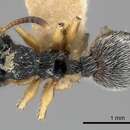en
names in breadcrumbs


Procryptocerus belti has been collected in both canopy and understory of primary rainforest, in second growth vegetation, in beach-edge vegetation, and in mangroves. Most collections are of foraging workers from low vegetation, but four nest series were collected from narrow-guage dead stems, at least one of which was detached and lodged in low vegetation. Collections have been made in the canopies of tall trees, including Brosimum, Sloanea, Ficus, and Leuhea. Specimens have been found in the feces of Cyclopes (silky anteater).
In Costa Rica, this species prefers seasonally dry habitats. It is very abundant in the lowlands of the Pacific side, south of Puntarenas, but is rare elsewhere. At La Selva Biological Station, in the wet Atlantic lowlands, it is a very rare element of the ant fauna, occurring sparsely in the tops of canopy trees.
Mexico to Panama, Ecuador. Costa Rica: abundant in the lowlands of the Pacific side, south of Puntarenas, rare elsewhere.
Taxonomic history
See also: Kempf, 1951 PDF: 31; Longino & Snelling, 2002 PDF: 11.